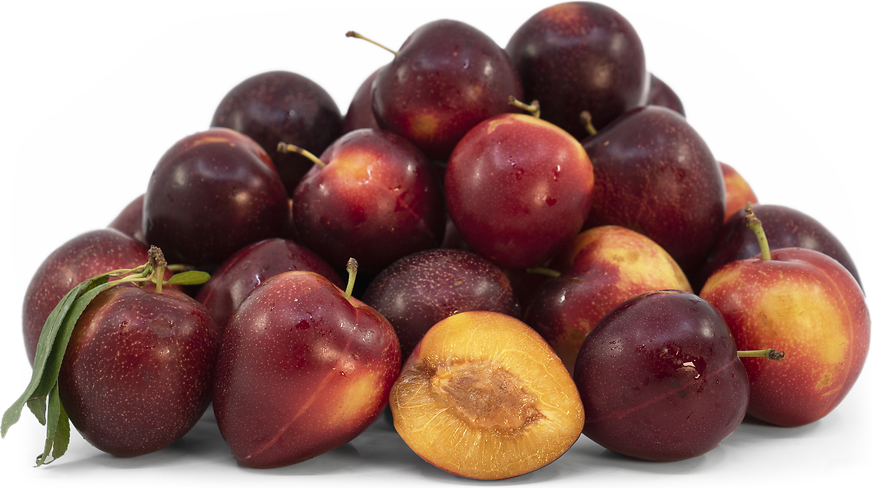


Cherry Plums
Estimated Inventory, lb : 0
Description/Taste
Cherry plums are small fruits, averaging 2 to 3 centimeters in diameter, and have an oval to round shape. The fruit’s skin is very thin, smooth, glossy, and taut, flushed with dark red, bright red, and golden hues, overlayed with a layer of light speckling. Underneath the surface, the vibrant yellow to amber flesh is dense, semi-firm, succulent, and aqueous with a soft, snap-like consistency. There is also a slender, central pit that is tightly adhered to the flesh and a distinct ring of pink-red pigment found just below the surface. Cherry plums contain high acidity when harvested young, contributing to a tart but refreshing sour flavor with green apple and lemon-like, fruity nuances. If the plums are left to mature on the tree, the flesh will continue to develop natural sugars and astringency, creating a balanced, sweet-tart, tangy flavor with fruity, spice-filled nuances.
Seasons/Availability
Cherry plums are available in the summer.
Current Facts
Cherry plums, botanically classified as Prunus cerasifera, are sweet-tart drupes that grow on deciduous trees belonging to the Rosaceae family. The fruits are native to Europe and Asia, having been cultivated since ancient times, and there are many different varieties of Cherry plums grown worldwide. Cherry plum trees are also known as Myrobalan plums and are considered highly ornamental in home gardens, favored for their showy flowers, brightly colored fruits, and pigmented foliage. Despite their cherrker, Cherry plums do not contain cherry ancestry, and the fruits are traditionally regarded as cooking fruits. The plum’s flavor depends on the specific variety, and the fruits are commonly incorporated into preserves or combined with sweeteners for savory cooked preparations. The most common commercial types of Cherry plums are Thundercloud, Nigra, Atropurpurea, and Newport. It is important to note that there are also hybrid fruits labeled cherry plums in California. The fruits were created in the early 21st century and are a natural cross between sweet cherries and plums, known as cherry plums, plum cherries, cherubs, and cherriums. Cherry plum hybrids are also sold under marketing names, including Pixie Sweet, Verry Cherry plums, Pluerry, Nadia, CherriYum!, and Gold Nugget. Prunus cerasifera and cherry plum hybrids are two distinct types of fruits and are not related, despite their similarity in appearance.
Nutritional Value
Cherry plums are a good source of potassium to balance fluid levels within the body and fiber to regulate the digestive tract. The fruits also contain some vitamin A to maintain healthy organ functioning, vitamin C to strengthen the immune system, iron to develop the protein hemoglobin for oxygen transport through the bloodstream, and other amounts of calcium, phosphate, and B complex vitamins, which can affect metabolism and nervous system health.
Applications
Cherry plums can be consumed, straight out of hand, discarding the central pit, but many varieties often carry a tart, somewhat sour flavor for fresh eating. The fruits are popularly combined with sugar or other sweeteners to create a balanced, sweet-tart flavor. Cherry plums are simmered into preserves, jams, and chutney or cooked and dried into fruit leather. The fruits can also be baked into muffins, crisps, crumbles, cakes, and pies, blended into sorbet, or tossed into salads with other sweet-flavored fruits for a dynamic flavor profile. In addition to sweet preparations, Cherry plums can be cooked into sauces and served with savory dishes, including roasted meats and vegetables. Cherry plums pair well with stone fruits such as apricots, peaches, and nectarines, nuts, including almonds, pecans, and pistachios, spices such as ginger, cardamom, cinnamon, and nutmeg, vanilla, chocolate, and meats such as pork, poultry, beef, and lamb. Whole, unwashed Cherry plums should be left at room temperature to rOnce soft and ready to eat, the fruits can be kept for an additional 3 to 5 days, depending on the variety and maturity, when stored in the refrigerator’s crisper drawer.
Ethnic/Cultural Info
Cherry plum trees are highly favored in Europe for their ornamental foliage and flowers. The flowers begin to bloom in the late winter and early spring, showcasing pink and white hues, and remain on the tree for an extended period. Cherry plum trees ae first trees to flower, acting as a sign that spring is approaching. During blooming, the foliage also contains a purple hue, contributing to the tree’s visual appeal in home gardens. Beyond the Cherry plum’s ornamental qualities, the fruits are traditionally consumed green and unripe in the Middle East, considered a delicacy when dipped in salt as a crunchy snack. Cherry plums are also the main ingredient in chakapuli stew, a Georgian dish frequently served during Easter. The lamb stew is flavored with unripe Cherry plums, either tossed in whole or made into a tart sauce known as tkemali, and is one of the most popular dishes served in Georgia. Tkemali is also a staple sauce in everyday Georgian kitchens, poured over roasted meats, eggs, or potatoes, or used as a dipping sauce for slices of the unripe plums.
Geography/History
Cherry plums are believed by experts to be native to Western Asia and Southeastern Europe, growing wild since ancient times. The fruits were also thought to have had a concentrated presence in the mountainous areas within the cities of Karaj, Tabriz, and Tehran in Iran. Many varieties of Cherry plums are consumed in their unripe, green stage and mature golden-red phase. The fruits thrive in temperate, cool climates, and over time, they were transported along trade routes and naturalized throughout Europe, the British Isles, and Eastern Asia. Cherry plums were also introduced to North America, where the trees are cultivated for their fruits and ornamental nature. Today Cherry plums are grown in the Middle East and on a small scale throughout North America, Australia, Asia, and Europe. When in season, Cherry plums can be found through farmer's markets, Asian grocers, specialty distributors, and online retailers.
Recipe Ideas
Recipes that include Cherry Plums. One
Podcasts

















